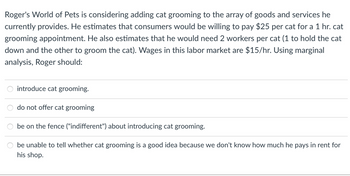
Economics (MindTap Course List)
13th Edition
ISBN: 9781337617383
Author: Roger A. Arnold
Publisher: Cengage Learning
expand_more
expand_more
format_list_bulleted
Question

Transcribed Image Text:Roger's World of Pets is considering adding cat grooming to the array of goods and services he
currently provides. He estimates that consumers would be willing to pay $25 per cat for a 1 hr. cat
grooming appointment. He also estimates that he would need 2 workers per cat (1 to hold the cat
down and the other to groom the cat). Wages in this labor market are $15/hr. Using marginal
analysis, Roger should:
introduce cat grooming.
do not offer cat grooming
be on the fence ("indifferent") about introducing cat grooming.
be unable to tell whether cat grooming is a good idea because we don't know how much he pays in rent for
his shop.
Expert Solution
This question has been solved!
Explore an expertly crafted, step-by-step solution for a thorough understanding of key concepts.
Step by stepSolved in 2 steps

Knowledge Booster
Learn more about
Need a deep-dive on the concept behind this application? Look no further. Learn more about this topic, economics and related others by exploring similar questions and additional content below.Similar questions
Recommended textbooks for you
 Economics (MindTap Course List)EconomicsISBN:9781337617383Author:Roger A. ArnoldPublisher:Cengage Learning
Economics (MindTap Course List)EconomicsISBN:9781337617383Author:Roger A. ArnoldPublisher:Cengage Learning




Economics (MindTap Course List)
Economics
ISBN:9781337617383
Author:Roger A. Arnold
Publisher:Cengage Learning




